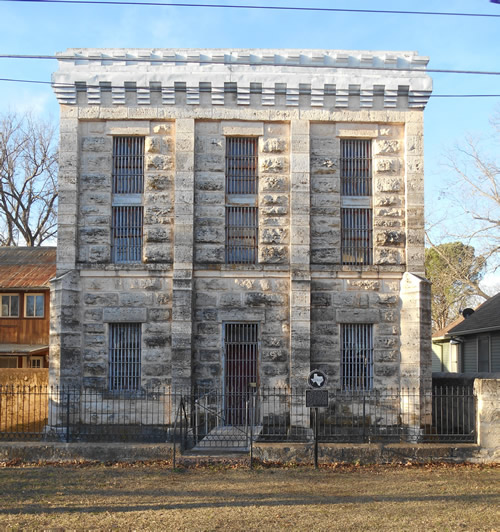Books by
Michael Barr
Order Here: |
|
| Esthetics
was an afterthought when Gillespie
County built a new jail in 1885. The rock and steel building,
which still stands on San Antonio Street in Fredericksburg,
is fortress-like and formidable. It has never been mistaken for a
B&B. It was designed and built for a single purpose: to keep prisoners
inside, and it wasn't always very good at that. |
 |
The county's
first jail, built in 1852, didn't stop prisoners from escaping, it
only slowed them down a bit. Minutes of the Commissioners Court stated
the jail was "badly built and afford(ed) no safety for prisoners,
several having broken out at various times without apparent difficulty."
In 1859 county commissioners ordered construction of a new jail. It
was "built of hard rocks," with 4 rooms - 3 above ground and 1 below.
While the 1859 jail was more secure, it sacrificed comfort. The sheriff
considered the building a health hazard. The air was "damp (with)
no sufficient ventilation, especially in the summertime."
In 1874 The Commissioner's Court withdrew $800 from the school fund
to build still another jail. It burned 10 years later.
Money
was tight when the county built the 1885 jail. The commissioner's
court purchased the lot on San Antonio Street for $150 but being unable
to fork over the full amount opted to pay the debt in $10 monthly
installments.
The jail, built at a cost of $10,000, is an austere 2-story building.
The design is functional. The steel clad cells are upstairs. Downstairs
is a holding room and living quarters for the jailer. A 5 ft. stone
wall, originally topped with shards of broken glass imbedded in the
concrete, surrounds the jail.
Builders made some allowances for comfort and convenience. The jail
had a wood stove for heat and a water well with an elevated tank that
channeled water to indoor sinks, water closets and privy.
Typical of jails of its time, it was hot in the summer and cold in
the winter. It was claustrophobic and unsanitary. And it smelled bad.
Security was lax. The jailer was apparently gone much of the time.
It was not uncommon for people to walk up to the jail, day or night,
and converse with prisoners through an open window.
Before WWI the jail sat
empty for extended periods. "Grain has been stored there, but it has
held very few prisoners," stated an article in the November 16, 1913
edition of the San Antonio Light. "County Judge Max Blum remarked
that there has not been a board bill for prisoners for the last two
terms of the court."
Indigents sometimes stayed at the jail. A former slave named Pete
Ferrel lived in a room there in exchange for odd jobs.
But
the incarceration business picked up after 1920, and with the rising
occupancy rate, combined with an aged facility, escape attempts were
more frequent.
In December 1923, 3 prisoners with a knife overpowered the jailer
and escaped.
In October 1926, 2 "desperate characters" sawed their way out of the
jail.
In July 1929, 5 prisoners tried to escape but officers, tipped off
by another inmate, foiled the plan. Constable Henry Schuch, who was
watching from a secret location, caught one of the prisoners sawing
the bars with a file.
In December 1930 a man broke into the building while the jailer was
away and threw the lever that opened the cells. The Fredericksburg
Standard called it one of "the cleanest jail deliveries ever recorded."
In 1935 a prisoner sawed 2 bars out of the window, jumped to the ground
unnoticed and fled into the night.
That same year another prisoner pried open a rusted steel covering
on the floor. He dropped to the first floor (it was unoccupied), opened
the front door (it was unlocked) and walked away.
One of the last escapees, before completion of a new jail on the top
floor of the courthouse in 1939, was one of the unluckiest. After
busting out he walked all night, stopping to rest at an empty cabin
near Stonewall.
The owner of the cabin, Deputy Sheriff Petmecky, found the intruder
in bed, just like Goldilocks. |
Sources:
"Town of Fredericksburg is Arcadia of the Southwest," The San Antonio
Light, November 16, 1913.
"Fredericksburg," Belton Journal, December 7, 1923.
"Two Men Break out of Jail at Fredericksburg," Brownwood Bulletin,
October 16, 1925.
"Prisoners Escape," Galveston Tribune, October 17, 1925.
"Gillespie County Jail Break Foiled," Abilene Morning News,
July 18, 1929.
"Man Held For Burglary Escaped For County Jail," Burnet Bulletin,
July 11, 1935.
"Prisoner escaped From County Jail," Harper Herald, September
12, 1935.
"Escaped Prisoner Is Brought To Kerrville," Kerrville Daily Times,
October 31, 1935.
"County Had Jail Before Courthouse," Fredericksburg Standard,
August 10, 1939. |
|
|
